Thursday, March 25, 2010
Epic Epicness Indeed
And then this happened and I had to spend the whole evening watching it over and over again while walking in smaller and smaller circles and pretending to fly across the room while punching things in slo-mo.
I'm excited, is what I'm saying.
Friday, March 5, 2010
Billions of Blue Blistering Barnacles!
So, I’m kicking around the library a week or two ago, and just out of curiosity I head over to the kid’s graphic novel section. While it’s expanded significantly in 20 years, there was nevertheless a pretty substantial assortment of graphic novels here back when I was a kid. Most of them were album collections of European comics, three titles in particular: The Smurfs, Asterix, and Tintin.
It was the Tintin books that I was most obsessed with as a kid for some reason, which in retrospect doesn’t make a lot of sense. The other two titles featured more appealing, expressive art (I thought so then and I think so now) as well as nifty fantasy elements in the case of the Smurfs, and epic historical adventure in the case of Asterix. They’re both also a LOT funnier and more well-characterized than Tintin.
…And looking at them now, I’m only just realizing what a huge subconscious influence they were on Lemuria--good grief. How did I not catch that? I guess it just shows how thoroughly I’ve internalized these comics.
I guess it’s not hard to see why a kid would read the Tintin books—the ligne claire style is still breathtakingly elegant, simple yet with lots of appealing detail. The various locales are captured in impressive detail; it’s no surprise that this comic was a huge influence on Stephen Spielberg (who, as you’ve no doubt heard, has a Tintin movie in production. And there’s no denying that Captain Haddock, Professor Calculus and Thompson and Thomson are entertaining sidekicks. Of course, Tintin himself remains a boring cipher whose few shreds of personality disappear whenever he’s around one of his sidekicks.
Anyway, it turned out there were several new Herge books on the shelves I hadn’t seen before, such as:

Yes, it’s the very first Tintin book ever. Along with Tintin In The Congo, it’s one of two not listed on the back of the Tintin collections. “Congo” is legendarily racist, being essentially a bit of blind boosterism for colonialism (Congo having been a Belgian colony at the time) and featuring some pretty over-the-top slaughter of animals, so it’s not hard to see why this story isn’t promoted much these days. But “Tintin in the Land of the Soviets” is pretty uncontroversial and is obviously historically significant. Its obscurity seems to boil down to the fact that it’s really not very well drawn.
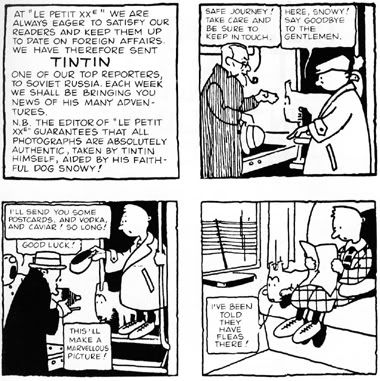
Georges “Herge” Remi drew these strips for Le Petit Vingtieme, a children’s supplement for the Catholic newspaper Le Vingtieme Siecle (“The 20th Century”). What I didn’t know what how blatantly the strip was intended as a work of propaganda at first. The strip was apparently commissioned by the editors as a full-frontal attack on Stalinist Russia, though, it must be said, it was an attack that turned out to be surprisingly accurate about some of the abuses that were going on in that country, particularly the widespread famine and poverty being covered up by the Soviet leaders. Though having Tintin randomly stumble across the supervillain-esque secret lair of Lenin, Stalin and Trotsky, protected by a haunted house of all things, might have been just a tad over-the-top.
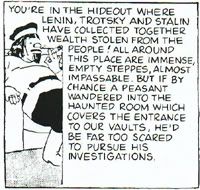
Right from the start, a lot of the Herge tropes are in place: Snowy/Milou the “talking” dog (who no one seems to be able to hear, not even Tintin):
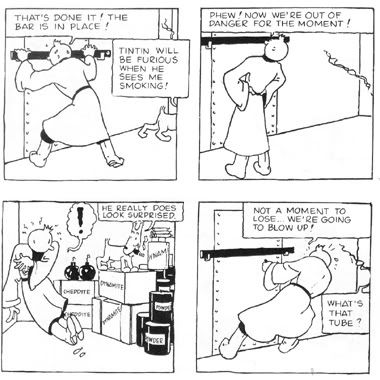
…an essentially realistic world that occasionally, and jarringly, reminds us that it is a cartoon:
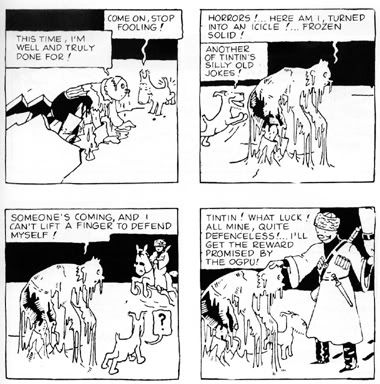
…and Tintin repeatedly triumphing, not by skill or smarts, but by repeated dumb luck and the idiocy of his enemies:
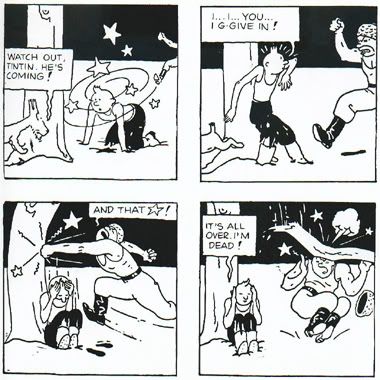
Of course, now that I know Tintin was explicitly intended to be Catholic, I suppose you could argue that it was God who kept saving his bacon in all those improbable ways.
Side note: this is also the first and only Tintin story in which Tintin, ace reporter, does any actual reporting.
As for the story, it’s a pretty repetitive and dull affair, filled with vaudeville humour (the series always traded in slapstick, especially once Captain Haddock joined the cast, but this was literally produced during the age of vaudeville). Basically, everywhere Tintin goes, the bad guys try to kill him, he escapes through pure luck and manages to single-handedly put a huge monkey wrench in the evil regime. It’s a wonder the Soviet Union hadn’t packed up and gone capitalist by the time Tintin leaves. What’s kind of hilarious, though, is that this story has exactly the same plot as Tintin in America, the third book, except there it’s gangsters who are constantly trying to kill him via elaborate deathtraps and failing due to idiocy and really, really bad luck (or good luck, from Tintin’s point of view). Herge was apparently an equal-opportunity critic when it came to capitalism and communism. It’s just too bad we never got to see Herge work his magic on the Nazis.
Oh, wait…there’s a reason for that...
Anyway, Tintin was an instant hit, and Herge became a sensation in Belgium and, a little later, Europe in general. This success enabled him to spend a lot more time working on the artwork of the strip, which very quickly went from the simple doodles of “Soviets” to incredibly lush, full-colour strips loaded with an almost insane amount of detail. Herge even went back and redrew some of the earliest books in order to unify their look (and remove some of the more unfortunate stuff from “Congo”, which Herge quickly realized had been insensitive and/or wrongheaded). European comics have always been filled with a lot more detail and background art than American or even Japanese comics; I suspect Herge is one of the forefathers of this tendency.
Herge cranked out a 62-page (or thereabouts) volume of Tintin every year or so from the 30s to the mid-50s. What’s astonishing is that this wasn’t all he was doing; he also launched a number of other comic strips, one a year for the first half of the 30s, though none of them lasted more than a single album. The exception was Quick and Flupke, a more gag-oriented strip about a couple of moppets that ran for a decade starting in 1930. As if all this wasn’t enough, Herge created yet another strip in 1936 that lasted for two decades: The Adventures of Jo, Zette and Jocko.
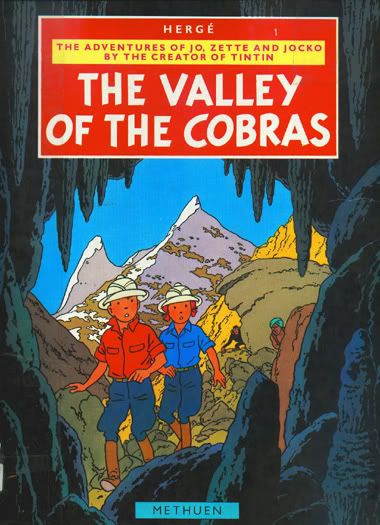
This strip seems to have been born out of the fact that Tintin, supposedly a teenager, didn’t much act like one; Jo and Zette LeGrand are much more believably rendered as kids, often in danger but never single-handedly defeating villains. Most of the actual action and competence is left to their engineer father.
And yet again, this was a work of propaganda, even though it was apolitical; it was commissioned by another Catholic newspaper to promote “family values”, i.e. a paradigm in which mom and kids are useless appendages and the dad does everything.
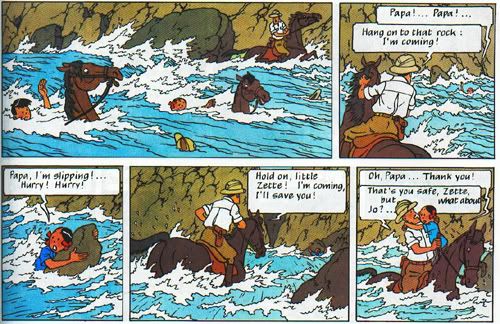
But hey, there’s a monkey! (That’s Jocko.) (And like Snowy, he talks, but none of the humans ever seem to hear him.)
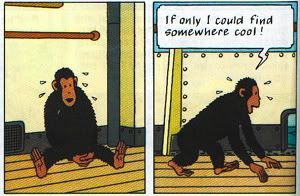
This is the only JZ&J book I’ve read, but once again the troubling (but complicated) racial and cultural undertones of so much of Herge’s work are present. This is embodied in The Maharajah of Gopal, the focus of much of the plot, and, really, the main character. He doesn’t get to kick ass like Mr. LeGrand, but he’s so much more compelling than anyone else in the story, even when for the first third he’s portrayed as a relentless jerk:
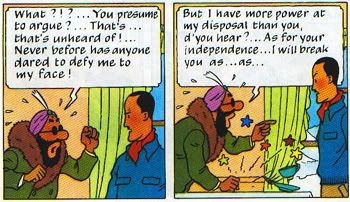
He’s basically a grown-up version of Abdullah, the spoiled brat son of an oil baron, who pops up in Tintin’s adventures. The Maharajah complains whenever someone shows him up, even accidentally; he relentlessly abuses his privilege, demanding canings and imprisonment for anyone who sets him off; he demands that everything conform to his worldview (to the extent that, when some jewels go missing and a detective is called in, he forces the detective to change into a Sherlock Holmes outfit before he’ll let him do his work); and he values objects over people. The plot is set in motion by the Maharajah’s desire to build a bridge in his homeland, which it’s eventually revealed is because he wants the money that will come with bridge fees.
His obnoxious puling eventually culminates in…oh dear…

Yes, that’s a civilian white dude spanking non-white royalty. Go ahead and guess if there are any consequences for this. No, seriously, guess.
To be fair, Herge seems to have had it in for the wealthy and privileged in general, rather than foreigners in particular. The Maharajah talks in immaculate English, and his faults aren’t associated with his race (his put-upon personal assistant seems like a perfectly decent and competent dude). And the Maharajah does redeem himself somewhat by the halfway point, revealing a more modest and friendly side…after he’s been spanked. Of course, when we get to Gopal, it’s full of scheming Indian stereotypes, including a treacherous Prime Minister and an evil Fakir.
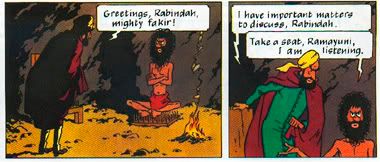
So really, not much there to be happy about.
What’s frustrating about all this is that Herge was a cosmopolitan guy who doesn’t seem to have had a trace of malice for anyone. This was all the result of ignorance and/or the genial insensitivity of a privileged white guy ensconced miles from the countries he was writing about. And of course, in some ways Herge was actually quite enlightened…his famous friendship with Chinese sculptor Chang Chong-jen led to a relatively sensitive and accurate portrayal of China in “The Blue Lotus”, and in the later books he clearly put a lot of effort into researching the various cultures he was portraying. It just shows how multifaceted and pernicious racism can be.
Oh well. Let’s move on to a later date, and the second-last Tintin book:
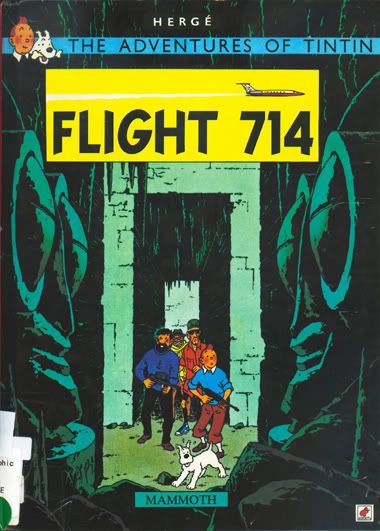
I grabbed this one because I remembered it being one of the few Tintin books with a SF element (“The Shooting Star” is the other one, unless you count the appearance of the Yeti in “Tintin in Tibet”). The last three Tintin books were produced at a very slow pace—understandable, since Herge had apparently become seriously burnt-out by the mid-50s, and anyway he’d become so successful that he didn’t really need to continue the series. Flight 714 came out in 1968, and it had clearly absorbed some of the then-trendy ideas of the time. Specifically: ancient astronauts.
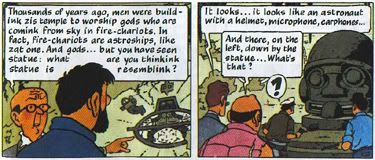
The story has the Tintin crew (no Thompson twins this time out) being hijacked and forced to land on a remote island somewhere in Indonesia. The mastermind turns out to be Tintin’s archnemesis, film director-turned-drug-dealer-turned-Blofeld-esque supervillain, Rastapopoulos.
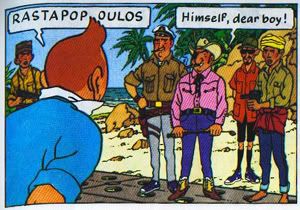
Despite what you might expect, it’s not an elaborate plan for revenge; Tintin’s presence is just another one of the many fantastical coincidences that populate Herge’s world. Rasta’s actually after the bank account of one Mr. Laszlo Carreidas, a miserable Ebenezer Scrooge-esque millionaire who’s nevertheless taken a shine to them, particularly Captain Haddock. Carreidas’s behaviour isn’t much better than the Maharajah’s, hence my comments about Herge having it in for rich folks.
At any rate, for the first half, this story is the usual sort of thriller, with the gang escaping Rastapopoulos and engaging in a series of action sequences, but then something weird happens: Tintin starts to hear voices…
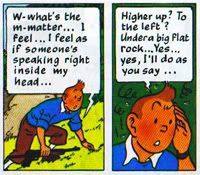
Which lead him to an underground space filled with mysterious artifacts of a bygone time…
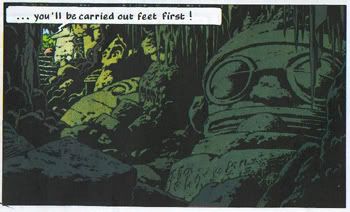
…Wait a minute. Mysterious island, strange voices, SF goings-on, a black rock, underground temples…there wouldn’t happen to be any incongruous polar bears on this island, would there, Tintin? Any sign of this symbol?

Well, I guess he doesn’t have much time to look around, being chased by terrorists and all. But if this IS the island from Lost, I can spoil the ending of the series for you: it’s aliens.
Somewhat jarringly, a mysterious Russian man, Mik Kanrokitoff, shows up to meet them and begins filling them in on a lot of X-Files-ish mumbo-jumbo about the island being a meeting place between aliens and a secret cabal of humans. Don’t worry, they’re perfectly benign—in fact, the only real purpose they serve in this story is to save the gang as the active volcano beneath the island erupts.
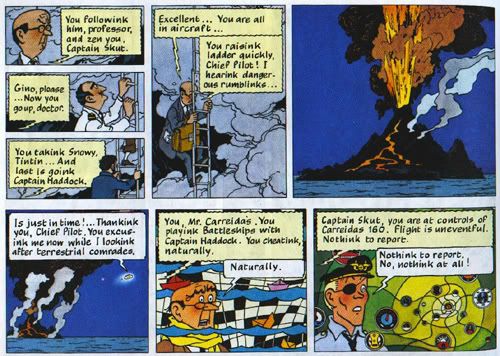
The aliens themselves never appear on-panel, and the heroes have a telepathic whammy put on them before they board the spacecraft, which leaves their memories completely erased afterwards. The story is clearly meant to emulate the various popular accounts of alien abduction, but it’s hard not to be a little frustrated by how much is left dangling at the end of this story—it feels like all buildup, no payoff. It certainly blows my mind that there were ever comics made that would AVOID showing aliens and spacecraft by any means necessary.
I set out to write something fond about Tintin, and of course I did feel a warm, fuzzy, nostalgic glow as I leafed through these books. But rereading them, I’m sort of disappointed by how dry and soulless they are, and how much objectionable content is present. The art remains magnificent, but there’s so little humanity in them, even aside from the regressive politics and the tiresome humour. It’s clear that Herge continued to learn and improve all his life, and the geniality of his creations still makes the books readable…barely. But I think I’m ready to throw these on the pile of “books I loved as a kid that don’t hold up.”
It was the Tintin books that I was most obsessed with as a kid for some reason, which in retrospect doesn’t make a lot of sense. The other two titles featured more appealing, expressive art (I thought so then and I think so now) as well as nifty fantasy elements in the case of the Smurfs, and epic historical adventure in the case of Asterix. They’re both also a LOT funnier and more well-characterized than Tintin.
…And looking at them now, I’m only just realizing what a huge subconscious influence they were on Lemuria--good grief. How did I not catch that? I guess it just shows how thoroughly I’ve internalized these comics.
I guess it’s not hard to see why a kid would read the Tintin books—the ligne claire style is still breathtakingly elegant, simple yet with lots of appealing detail. The various locales are captured in impressive detail; it’s no surprise that this comic was a huge influence on Stephen Spielberg (who, as you’ve no doubt heard, has a Tintin movie in production. And there’s no denying that Captain Haddock, Professor Calculus and Thompson and Thomson are entertaining sidekicks. Of course, Tintin himself remains a boring cipher whose few shreds of personality disappear whenever he’s around one of his sidekicks.
Anyway, it turned out there were several new Herge books on the shelves I hadn’t seen before, such as:

Yes, it’s the very first Tintin book ever. Along with Tintin In The Congo, it’s one of two not listed on the back of the Tintin collections. “Congo” is legendarily racist, being essentially a bit of blind boosterism for colonialism (Congo having been a Belgian colony at the time) and featuring some pretty over-the-top slaughter of animals, so it’s not hard to see why this story isn’t promoted much these days. But “Tintin in the Land of the Soviets” is pretty uncontroversial and is obviously historically significant. Its obscurity seems to boil down to the fact that it’s really not very well drawn.

Georges “Herge” Remi drew these strips for Le Petit Vingtieme, a children’s supplement for the Catholic newspaper Le Vingtieme Siecle (“The 20th Century”). What I didn’t know what how blatantly the strip was intended as a work of propaganda at first. The strip was apparently commissioned by the editors as a full-frontal attack on Stalinist Russia, though, it must be said, it was an attack that turned out to be surprisingly accurate about some of the abuses that were going on in that country, particularly the widespread famine and poverty being covered up by the Soviet leaders. Though having Tintin randomly stumble across the supervillain-esque secret lair of Lenin, Stalin and Trotsky, protected by a haunted house of all things, might have been just a tad over-the-top.

Right from the start, a lot of the Herge tropes are in place: Snowy/Milou the “talking” dog (who no one seems to be able to hear, not even Tintin):

…an essentially realistic world that occasionally, and jarringly, reminds us that it is a cartoon:

…and Tintin repeatedly triumphing, not by skill or smarts, but by repeated dumb luck and the idiocy of his enemies:

Of course, now that I know Tintin was explicitly intended to be Catholic, I suppose you could argue that it was God who kept saving his bacon in all those improbable ways.
Side note: this is also the first and only Tintin story in which Tintin, ace reporter, does any actual reporting.
As for the story, it’s a pretty repetitive and dull affair, filled with vaudeville humour (the series always traded in slapstick, especially once Captain Haddock joined the cast, but this was literally produced during the age of vaudeville). Basically, everywhere Tintin goes, the bad guys try to kill him, he escapes through pure luck and manages to single-handedly put a huge monkey wrench in the evil regime. It’s a wonder the Soviet Union hadn’t packed up and gone capitalist by the time Tintin leaves. What’s kind of hilarious, though, is that this story has exactly the same plot as Tintin in America, the third book, except there it’s gangsters who are constantly trying to kill him via elaborate deathtraps and failing due to idiocy and really, really bad luck (or good luck, from Tintin’s point of view). Herge was apparently an equal-opportunity critic when it came to capitalism and communism. It’s just too bad we never got to see Herge work his magic on the Nazis.
Oh, wait…there’s a reason for that...
Anyway, Tintin was an instant hit, and Herge became a sensation in Belgium and, a little later, Europe in general. This success enabled him to spend a lot more time working on the artwork of the strip, which very quickly went from the simple doodles of “Soviets” to incredibly lush, full-colour strips loaded with an almost insane amount of detail. Herge even went back and redrew some of the earliest books in order to unify their look (and remove some of the more unfortunate stuff from “Congo”, which Herge quickly realized had been insensitive and/or wrongheaded). European comics have always been filled with a lot more detail and background art than American or even Japanese comics; I suspect Herge is one of the forefathers of this tendency.
Herge cranked out a 62-page (or thereabouts) volume of Tintin every year or so from the 30s to the mid-50s. What’s astonishing is that this wasn’t all he was doing; he also launched a number of other comic strips, one a year for the first half of the 30s, though none of them lasted more than a single album. The exception was Quick and Flupke, a more gag-oriented strip about a couple of moppets that ran for a decade starting in 1930. As if all this wasn’t enough, Herge created yet another strip in 1936 that lasted for two decades: The Adventures of Jo, Zette and Jocko.

This strip seems to have been born out of the fact that Tintin, supposedly a teenager, didn’t much act like one; Jo and Zette LeGrand are much more believably rendered as kids, often in danger but never single-handedly defeating villains. Most of the actual action and competence is left to their engineer father.
And yet again, this was a work of propaganda, even though it was apolitical; it was commissioned by another Catholic newspaper to promote “family values”, i.e. a paradigm in which mom and kids are useless appendages and the dad does everything.

But hey, there’s a monkey! (That’s Jocko.) (And like Snowy, he talks, but none of the humans ever seem to hear him.)

This is the only JZ&J book I’ve read, but once again the troubling (but complicated) racial and cultural undertones of so much of Herge’s work are present. This is embodied in The Maharajah of Gopal, the focus of much of the plot, and, really, the main character. He doesn’t get to kick ass like Mr. LeGrand, but he’s so much more compelling than anyone else in the story, even when for the first third he’s portrayed as a relentless jerk:

He’s basically a grown-up version of Abdullah, the spoiled brat son of an oil baron, who pops up in Tintin’s adventures. The Maharajah complains whenever someone shows him up, even accidentally; he relentlessly abuses his privilege, demanding canings and imprisonment for anyone who sets him off; he demands that everything conform to his worldview (to the extent that, when some jewels go missing and a detective is called in, he forces the detective to change into a Sherlock Holmes outfit before he’ll let him do his work); and he values objects over people. The plot is set in motion by the Maharajah’s desire to build a bridge in his homeland, which it’s eventually revealed is because he wants the money that will come with bridge fees.
His obnoxious puling eventually culminates in…oh dear…

Yes, that’s a civilian white dude spanking non-white royalty. Go ahead and guess if there are any consequences for this. No, seriously, guess.
To be fair, Herge seems to have had it in for the wealthy and privileged in general, rather than foreigners in particular. The Maharajah talks in immaculate English, and his faults aren’t associated with his race (his put-upon personal assistant seems like a perfectly decent and competent dude). And the Maharajah does redeem himself somewhat by the halfway point, revealing a more modest and friendly side…after he’s been spanked. Of course, when we get to Gopal, it’s full of scheming Indian stereotypes, including a treacherous Prime Minister and an evil Fakir.

So really, not much there to be happy about.
What’s frustrating about all this is that Herge was a cosmopolitan guy who doesn’t seem to have had a trace of malice for anyone. This was all the result of ignorance and/or the genial insensitivity of a privileged white guy ensconced miles from the countries he was writing about. And of course, in some ways Herge was actually quite enlightened…his famous friendship with Chinese sculptor Chang Chong-jen led to a relatively sensitive and accurate portrayal of China in “The Blue Lotus”, and in the later books he clearly put a lot of effort into researching the various cultures he was portraying. It just shows how multifaceted and pernicious racism can be.
Oh well. Let’s move on to a later date, and the second-last Tintin book:

I grabbed this one because I remembered it being one of the few Tintin books with a SF element (“The Shooting Star” is the other one, unless you count the appearance of the Yeti in “Tintin in Tibet”). The last three Tintin books were produced at a very slow pace—understandable, since Herge had apparently become seriously burnt-out by the mid-50s, and anyway he’d become so successful that he didn’t really need to continue the series. Flight 714 came out in 1968, and it had clearly absorbed some of the then-trendy ideas of the time. Specifically: ancient astronauts.

The story has the Tintin crew (no Thompson twins this time out) being hijacked and forced to land on a remote island somewhere in Indonesia. The mastermind turns out to be Tintin’s archnemesis, film director-turned-drug-dealer-turned-Blofeld-esque supervillain, Rastapopoulos.

Despite what you might expect, it’s not an elaborate plan for revenge; Tintin’s presence is just another one of the many fantastical coincidences that populate Herge’s world. Rasta’s actually after the bank account of one Mr. Laszlo Carreidas, a miserable Ebenezer Scrooge-esque millionaire who’s nevertheless taken a shine to them, particularly Captain Haddock. Carreidas’s behaviour isn’t much better than the Maharajah’s, hence my comments about Herge having it in for rich folks.
At any rate, for the first half, this story is the usual sort of thriller, with the gang escaping Rastapopoulos and engaging in a series of action sequences, but then something weird happens: Tintin starts to hear voices…

Which lead him to an underground space filled with mysterious artifacts of a bygone time…

…Wait a minute. Mysterious island, strange voices, SF goings-on, a black rock, underground temples…there wouldn’t happen to be any incongruous polar bears on this island, would there, Tintin? Any sign of this symbol?

Well, I guess he doesn’t have much time to look around, being chased by terrorists and all. But if this IS the island from Lost, I can spoil the ending of the series for you: it’s aliens.
Somewhat jarringly, a mysterious Russian man, Mik Kanrokitoff, shows up to meet them and begins filling them in on a lot of X-Files-ish mumbo-jumbo about the island being a meeting place between aliens and a secret cabal of humans. Don’t worry, they’re perfectly benign—in fact, the only real purpose they serve in this story is to save the gang as the active volcano beneath the island erupts.

The aliens themselves never appear on-panel, and the heroes have a telepathic whammy put on them before they board the spacecraft, which leaves their memories completely erased afterwards. The story is clearly meant to emulate the various popular accounts of alien abduction, but it’s hard not to be a little frustrated by how much is left dangling at the end of this story—it feels like all buildup, no payoff. It certainly blows my mind that there were ever comics made that would AVOID showing aliens and spacecraft by any means necessary.
I set out to write something fond about Tintin, and of course I did feel a warm, fuzzy, nostalgic glow as I leafed through these books. But rereading them, I’m sort of disappointed by how dry and soulless they are, and how much objectionable content is present. The art remains magnificent, but there’s so little humanity in them, even aside from the regressive politics and the tiresome humour. It’s clear that Herge continued to learn and improve all his life, and the geniality of his creations still makes the books readable…barely. But I think I’m ready to throw these on the pile of “books I loved as a kid that don’t hold up.”
Subscribe to:
Comments (Atom)